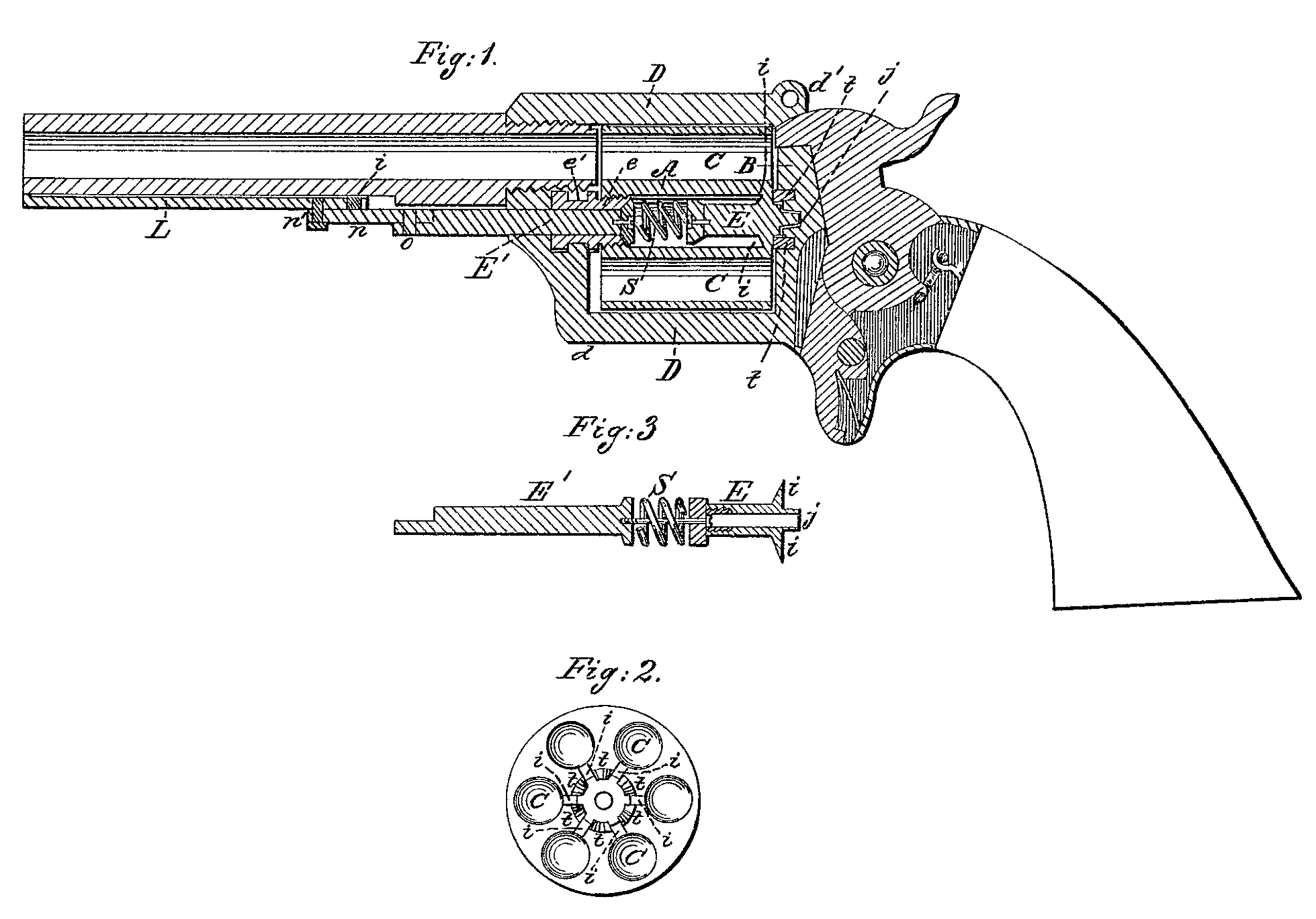US 93572
UNITED STATES PATENT OFFICE.
ROLLIN WHITE, OF LOWELL, MASSACHUSETTS.
IMPROVEMENT IN REVOLVING FIRE-ARMS.
Specification forming part of Letters Patent No. 93,572, dated August 10, 1869.
To all whom, it may concern:
Be it known that I, ROLLIN WHITE, of Lowell, in the county of Middlesex and State of Massachusetts, have invented a new and useful Improvement in Revolving Fire-Arms; and I do hereby declare that the following is a full clear, and exact description thereof, reference being had to the accompanying drawings and the letters of reference marked thereon.
This invention relates to that class of revolvers in which the charge-chambers are bored clear through the cylinder, and in which metallic flanged cartridge-cases are used, being inserted and withdrawn at the rear; and its object is to facilitate the simultaneous ejection of the discharged cartridge-shells.
Figure 1 of the accompanying drawings is a longitudinal section through the center of a Fig. 2 is a view of the rear end of the revolving cylinder, and Fig. 3 is a modification of the plunger and ejector.
A is the revolving cylinder; B, the recoil shield; C, the charge-chambers, bored clear through the cylinder; and D, the frame in which the cylinder revolves. Said frame opens at a joint, d, turning upon a hinge-joint, d’, so that the position of the barrel and cylinder may be reversed, leaving the rear end of the cylinder clear and unobstructed for the ejection of the cartridge. The joint d is locked and released by means of a spring-catch, a. The cylinder is held in the frame by means of a thimble, e, screwed into its front end, with an annular groove, e’, around it, fitting in to a recess in the frame, of like form, and the plunger-rod E’ passing through the front part of the frame and the thimble.
E is the cartridge-ejector, with radial teeth i i extending to the edges of the charge-chambers, and countersunk into the rear end of the cylinder. The ratchet-teeth t t, by which the cylinder is revolved, are on the cylinder, and ejector-teeth fit in between them. The ejector is prevented from turning in the cylinder by a spline and feather. The journal j, on which the cylinder revolves at its rear end, is on the ejector, and the plunger-rod E is the journal upon which its front end revolves. Between the ejector E and the plunger E’ a spiral spring, S, is interposed within the center bore of the cylinder.
L is a lever pivoted to the barrel at l, and n is a link pivoted to said lever at n’ and to the plunger-rod at o, for operating the plunger.
The flanges of the cartridge-cases overlap the ejector-teeth i, so that the ejector cannot move back without carrying all the cartridge shells with it. When the plunger is forced down by means of the lever L the spiral spring will be compressed before the ejector begins to move, and then the plunger, spring, and eject or will all move together until the shells are partially ejected from the chambers; but before they are completely ejected the binding or friction between the shells and the chambers will become so diminished that the spring will suddenly react, throwing all the shells out of the way by a quick motion.
There are manifest advantages in having the ratchet-teeth on or attached to the cylinder instead of the cartridge-ejector, as the cylinder will be more firm and positive in its movements, and the ratchet will always maintain the same relations to the chambers, being in no way affected by the wear, loose fitting, rusting, or fouling of the ejector.
The journal j, on which the rear end of the cylinder revolves, may be screwed into the end of the ejector, as shown in Fig. 2, so that when worn a new one may be easily substituted.
The points of the ejector-teeth i i are slightly serrated or roughened, to take a better hold on the flanges of the cartridge-shells and prevent them from slipping.
Having thus fully described my invention and the various modes of carrying it into effect, what I claim as new, and desire to secure by Letters Patent, is–
1. In combination with a revolving cylinder and a cartridge-ejector, consisting of a central sliding rod with radial teeth or equivalent projections to seize and carry out the cartridge cases, a ratchet to revolve the cylinder, made on or attached to the cylinder, substantially as herein shown and described.
2. In combination with a plunger and ejector unconnected, as described, a lever to operate the plunger, substantially as described.
3. A spring interposed between the plunger and the ejector, whether the same are connected by a swivel-joint, or unconnected, substantially as and for the purpose set forth.
4. In combination with the cartridge-ejector E, the serrated or roughened teeth i i, substantially as and for the purpose described.
ROLLIN WHITE.
Witnesses:
KENNETH. G. WHITE,
R. E. STILLWELL.

